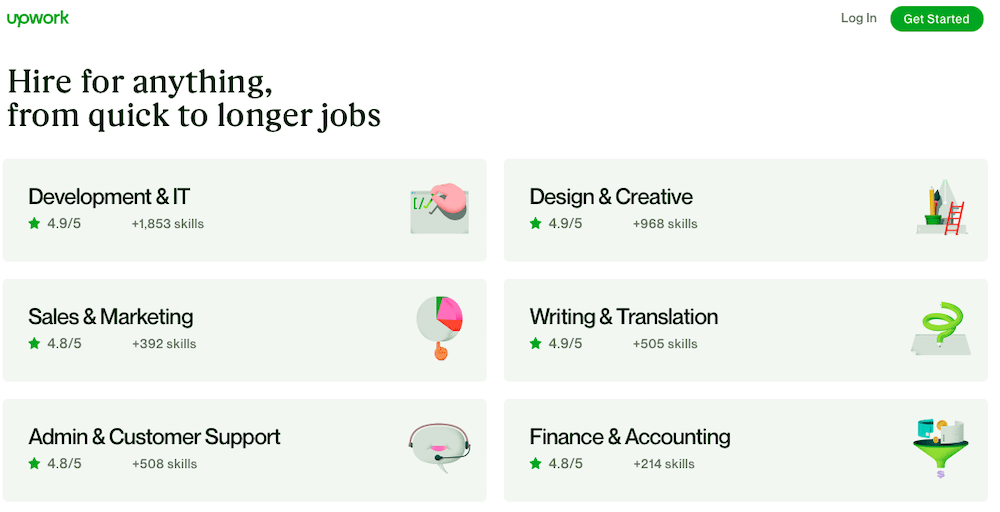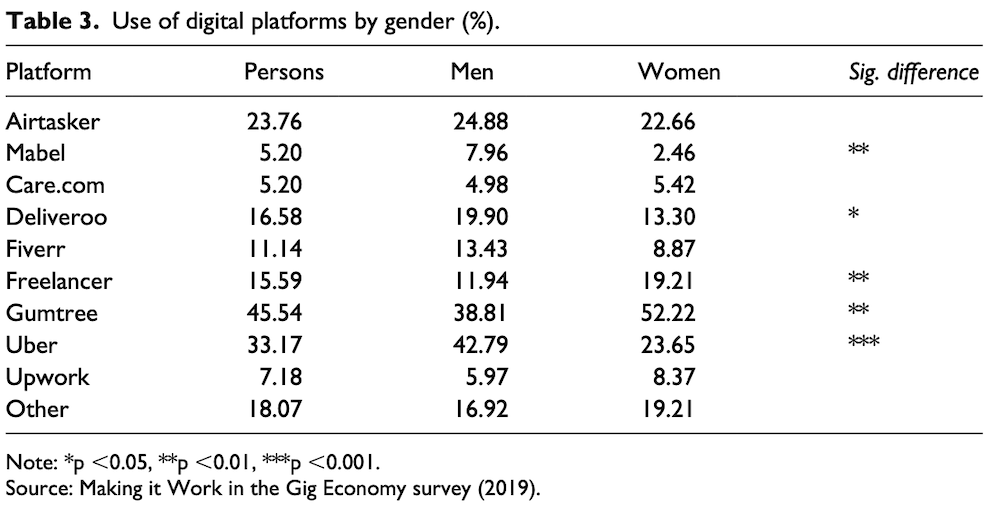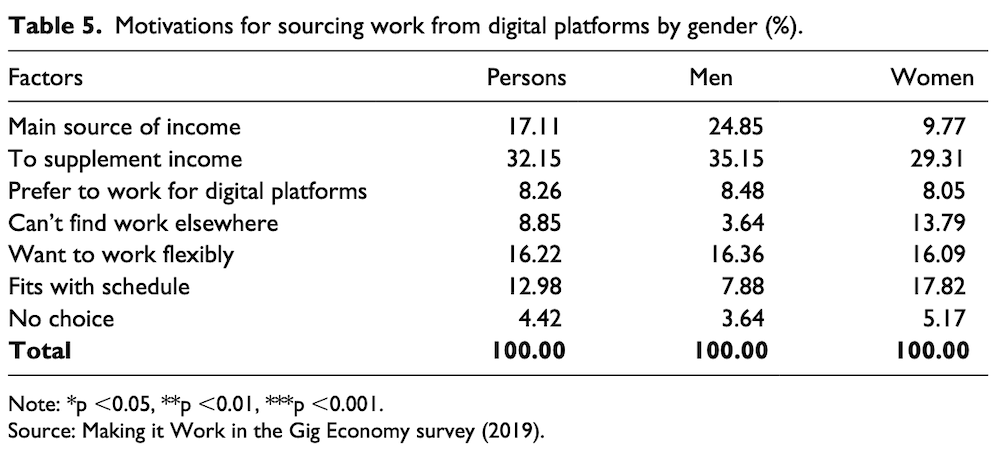Women in the gig economy have not been adequately looked at.
At least for me and I was curious. How do the dynamics operate in the new business paradigm? Maybe this is an opportune time to see if there is more to this than meets the eye. Are there unexpected outliers or is it no different to the conventional economy work wise?
The focus on women rather than men who tend to be the default was not planned. To be honest it was an after-thought. Mainly because Australia had closed the gender gap better than many countries.
As I dug deeper there is little published material on the gender aspect.
Companies like Uber and DoorDash have done some level of gender research but not across the gig industry. Mainly to see their own opportunities and challenges.
Online gig platforms and gender
One offshoot of the gig economy is the genesis of digital online platforms to seek work.
The reason I brought up digital online platform is the belief that it will appeal to the female gender for reasons that are different to the male gender. And I had to find out if the belief held.
I covered the emergence of online gig platforms in my previous posts on the gig economy but a refresh might help. Here is that post.
These digital online gig platforms sit between those seeking work and those who are looking for workers.
The platforms are the digital brokers in the work and employment space.
The dynamics in this space is so different from conventional recruitment firms. It is no longer one way. It works both ways but there is now more of a position of strength for those seeking work. You could state your terms in many cases. Try that with the conventional recruitment firms.

A caveat first
This is not an attempt to stereotype women as home bound or where their place in the family should be.
They have traditionally handled the “family caring role”. And there is no change even if they are in full employment or running their own businesses.
There is also difference to what many associate the gig economy to be, ride hailing and food delivery couriers. We now know that the gig economy has grown horizontally and vertically across business sectors.
In the original and first sectors individuals approach Uber, DoorDash, Deliveroo etc directly. The work is physical in nature and physical contact is necessary. The work cannot be done in the confines of a home.
Spouses and partners who are home bound for raising their children for example are predominately women. This is where flexibility plays a huge part and appeals to the female gender. The ability to pick and choose hours or days in the week. And most importantly the nature of the work.
Even before online gig platforms surfaced, women have been involved in online sales from their homes. An extension is running their own online businesses rather being employed by others. Again from the home. So remote working is not new but this looks into remote working in the gig world.
Safety factor
Personal safety is a key factor. There are opportunities in the gig space that are a lot safer than being an Uber driver or Deliveroo food courier. Though I understand women participating in this sector is above 40%.
If you step back and have a look at the gig economy and where online platforms are concerned, the security and safety advantage are noticeable. If I am looking for safety and security as a key factor, it will be top of mind when I browse for opportunities.
As I got deeper into this, I wondered why these are not highlighted or recognised to the extent it should be.
I have yet to see a focus article on the its advantage for females to use online platforms.
Women focused themes
Are there opportunities for platform operators for additional revenue streams if there is a focus on women? I would think so.
We are aware that working and professional women are more likely to stop work for family reasons. Some are prepared to switch careers to devote more time to the family.

I do recall early in my early career being paired with a staff member in our New York head office for training.
Within an hour, I realised that she was overqualified.
She previously held a senior role in another company. She changed careers as she wanted to select the hours she worked, for family reasons. Her family was young.
In essence women do make a deliberate choice to undertake work below their qualifications or even experience but driven by desire to provide the caring element in the family nucleus.
In simple terms, less hours, less demanding work and less pay. They also have no issues being the secondary income earners. Maybe not all.
Mansplaining and women plumbers
Here is another gender specific opportunity to consider. I saw a South Korean article where there is a preference by women customers to look for women plumbers and electricians. In this respect it was more along the lines of avoiding “mansplaining”. A well known problem all around the World.
Women who are asked if their husband or male partner will be around when trades people turn up for a quote is not uncommon.
By the way, I have been asked if the lady of the house will be around when solar panel requirements are discussed. I suspect they wanted all possible decision makers to be present. Hedging their bets on who actually wears the pants in the house.
By the way Mrs Falcon handled our ageing ducted air conditioning replacement from start to finish as I was away. Including negotiating with a second tradesperson to patch up the brickwork with original second hand bricks. There goes one stereotype out the window.

An interesting gender study
“Gender in the gig economy: Men and women using digital platforms to secure work in Australia” was published in 2019 in the Journal of Sociology.
The authors are Brendan Churchill and Lyn Craig from the School of Social and Political Sciences, University of Melbourne, Australia.
I picked this particular study as it is interesting to identify gender specific issues.
It was also Australian based. And I did mention early there is hardly any published material so this is well received.
They broke down the popular digital online gig platforms having realised that not all are generic in nature and some are focused on certain sectors.
The distribution
Women outstripped men in Gumtree, Upwork and Freelancer and edged men in Care.com in terms of participation. They were slightly behind with Airtasker.

Men outstripped women in Mabel, Deliveroo and Uber. The last two is not surprise.
As mentioned earlier when it comes to ride hailing and food couriers services in view of safety concerns and the need to work away from the home. Mabel’s focus is on disability and aged care work. This meant leaving the home and generally not as flexible.
The wide distribution reflects the appeal of some platforms for women due to the nature of jobs or tasks that they offer.
Upwork and Freelancer are similar in their offerings. The key is working from home.
It is also more on the professional side in terms of qualification. From admin, accounting, digital, graphic design, animation , programming and the likes. It allows flexibility for a well qualified women who prefer such assignments which do not require frequent supervision. This is includes digital marketing or making sales calls or handling level one enquiries.
Gumtree and Airtasker is more along the lines of care, cleaning, housekeeping and handyman tasks. Fiverr is similar to Upwork and Freelancer but the distribution was a direct opposite. I could not work out why.
Reasons why
The study also sought respondents’ reasons for seeking work on the gig digital platforms. There were no surprises.

4 main reasons stood out compared to men.
Women wanted the work to fit their schedule and they were not seeking work as the primary source of income. That covered two out of the four reasons.
Two remaining factors however are negatives. They reflect the continued discrimination of women in the workspace. “Can’t find work elsewhere” and “no choice”. Truly regrettable.
For ”can’t find work elsewhere”, it was significantly wide, 4 times more than men. The extent of the gap is a surprise. If this does not register, nothing will.
What next?
I did take into account that it is one study and the scale of the sample size. Nevertheless it did not throw out any surprises with one exception. It did show that discrimination continues to exist.
On the positive side, women in the gig economy cannot be ignored. The digital online platforms for the gig economy has provided the female gender with better options and brings them closer to running their own agenda.
The lack of female focused and female friendly digital online platforms is obvious.
Platforms like Fiverr, Upwork and Freelancer could easily host one within their existing business model. The same technical backend but with female focused front-end.
At the very least it will provide first mover advantage against the wider competition.
My guess is platform choices are inelastic to users. Once they are comfortable with one they will remain with that platform for most of their work. Similar to opening your first bank account.
